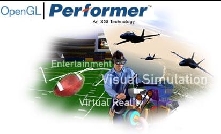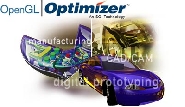The graphics libraries from SGI
-
OpenGL is a graphical library introduced by Silicon Graphics in 1992
-
Allows developers to write a single piece of code which is supposed to run in various platforms (as long as they have an OpenGL library implementation)
-
Broadly used
-
Hardware acceleration
-
Not OO
-
Rendering and Graphics
-
OpenGL Architecture Review Board, http://www.opengl.org
OpenGL |
 |
Open InventorThe OO format of SGI |
 |
OpenGL PerformerOpenGL Performer provides a powerful and extensible programming interface (with ANSI C and C++ bindings) for creating real-time visual simulation and other interactive graphics applications. |
 |
OpenGL Multipipe
|
 |
OpenGL is a graphical library introduced by Silicon Graphics in 1992 to allow developers to write a single piece of code, based on the OpenGL API2, which is supposed to run in various platforms (as long as they have an OpenGL library implementation).
Since its inception OpenGL has been controlled by an Architectural Review Board whose representatives are from the following companies: 3DLabs, Compaq, Evans & Sutherland (Accelgraphics), Hewlett-Packard, IBM, Intel, Intergraph, NVIDIA, Microsoft, and Silicon Graphics.
Most of the Computer Graphics research (and implementation) broadly uses OpenGL which has became a de facto standard. Virtual Reality is no exception to this rule.
OpenGL Architecture Review Board, http://www.opengl.org
There are many options available for hardware acceleration of OpenGL based applications. The idea is that some complex operations may be performed by specific hardware (an OpenGL accelerated video card such as those based on 3DLab’s Permedia series or Mitsubishi’s 3Dpro chipset for instance) instead of the CPU which is not optimized for such operations. Such acceleration allows low-end workstations to perform quite well yet at low cost.
We will see that such is the importance of OpenGL that both VRML and Java3D are built on top of it, i.e. if a given workstation has hardware support for OpenGL the VRML browser and Java3D, will also benefit from it.
These standards are mainly concerned with graphics and rendering of 3D scene graphs. They have very little or no consideration about communication between users and other networking related issues.